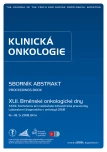A Development and Overview of the Use of Chemotherapy and the Role of Radiotherapy and Surgery in Patients with Newly Diagnosed Pancreatic Tumor and Cancer in the Current 5-year Center Practice
Authors:
S. Vokurka; M. Votavová; J. Kulhánková; H. Korunková; O. Fiala; K. Štěrbová; T. Svoboda; R. Vojtíšek; VM. Matějka; J. Fínek
Authors‘ workplace:
Onkologická a radioterapeutická klinika LF UK a FN Plzeň
Published in:
Klin Onkol 2018; 31(Supplementum1): 171-173
Category:
Article
Overview
Background:
Chemotherapy (CHT), surgery and radiotherapy (RT) are essential modalities in the treatment of pancreatic malignancies. Their use in practice may be influenced by a number of factors.
Patients and Methods:
Retrospective analysis of CHT, surgery and RT indications and CHT results in patients reported with pancreatic tumor in Pilsen in 2012–2016.
Results:
A total of 348 patients with median age 68 (19–89) years with newly diagnosed pancreatic tumor, resp., with histology/cytology verified carcinoma in 74.5% cases, with v. s. carcinoma without verification in 21% and with other malignancy not further analyzed here in 4.5% (mostly neuroendocrine tumor). In patients with generalized malignancy (n = 195), exploratory laparotomy was performed in 23% to get tissue samples or verify staging – palliative anastomoses were done in 25% of operated patients, CHT was performed in 29% of the generalized tumors, palliative RT of tumor was performed in 1 patient, and RT of metastases in 3 patients. In patients with local or regional nodal affection (n = 137) laparotomy was done in 59%, R0 resection in 34 (42%) of 81 operated, R1 in 6%, palliative anastomoses were done in 17% and irreversible electroporation in one patients, CHT or radiochemotherapy after R0 and R1 resections was provided in 61% operated patients. The most commonly used CHT was monotherapy with gemcitabine or FOLFIRINOX. The indication of CHT in cytology/histology verified generalized cancers and with excluding patients refusing CHT was proposed in 2012 to 16%, in 2014 to 49% and in 2016 to 84% of patients. In the case of a local or regional nodal involvement the CHT was proposed to 40, 55 and 86% of patients. Median overall survival in generalized tumor patients receiving CHT (n = 137) vs. not-receiving CHT (n = 56) was 2 vs. 8 months (p = 0.0001), and in the local or regional nodal involvement patients receiving CHT (n = 74) vs. not-receiving CHT (n = 62) was 5 vs. 16 months (p = 0.0001).
Conclusion:
CHT and surgery are the dominant treatment modalities. There has been a marked increase in the CHT and histology/cytology verifications indications, with a major factor being a clinician evaluation of a patient to be fit for CHT and its benefit or to complete pancreatic tumor verification. With still very limited results in pancreatic cancer treatment, a careful assessment of each patient’s indication, respecting patient’s desire, is always required, knowing that even in the case of advanced disease, CHT can bring benefit, albeit limited.
Key words:
pancreas – carcinoma – chemotherapy
The authors declare they have no potential conflicts of interest concerning drugs, products, or services used in the study.
The Editorial Board declares that the manuscript met the ICMJE recommendation for biomedical papers.
This study was supported by the grant of Ministry of Health of the Czech Republic – Conceptual Development of Research Organization (Faculty Hospital in Pilsen – FNPl, 00669806).
Submitted:
13. 3. 2018
Accepted:
18. 4. 2018
Sources
1. Čečka F, Jon B, Dvořák J et al. Paliativní chirurgická léčba nádorů pankreatu a periampulární oblasti. Klin Onkol 2012; 25 (2): 117–123. doi: 10.14735/amko2012 117.
2. Rahib L, Fleshman J, Matrisian L et al. Evaluation of Pancreatic Cancer Clinical Trials and Benchmarks for Clinically Meaningful Future Trials A Systematic Review. JAMA Oncol 2016; 2 (9): 1209–1216. doi: 10.1001/jamaoncol.2016.0585.
3. Novotný J, Halámková J, Vítek P et al. Karcinom slinivky břišní (C25) . In: Novotný J, Vítek P, Kleibl Z (eds) . Onkologie v klinické praxi. Standardní přístupy v diagnostice a léčbě vybraných zhoubných nádorů. 2. vyd. Praha: Mladá fronta 2016: 214–230.
Labels
Paediatric clinical oncology Surgery Clinical oncologyArticle was published in
Clinical Oncology

2018 Issue Supplementum1
- Metamizole at a Glance and in Practice – Effective Non-Opioid Analgesic for All Ages
- Metamizole vs. Tramadol in Postoperative Analgesia
- Possibilities of Using Metamizole in the Treatment of Acute Primary Headaches
- Current Insights into the Antispasmodic and Analgesic Effects of Metamizole on the Gastrointestinal Tract
- Safety and Tolerance of Metamizole in Postoperative Analgesia in Children
Most read in this issue
- MicroRNA Analysis for Extramedullary Multiple Myeloma Relapse
- A Development and Overview of the Use of Chemotherapy and the Role of Radiotherapy and Surgery in Patients with Newly Diagnosed Pancreatic Tumor and Cancer in the Current 5-year Center Practice
- Flow Cytometric Analysis of Nucleoside Transporters Activity in Chemoresistant Prostate Cancer Model
- MicroRNAs in Prediction of Response to Radiotherapy in Head and Neck Cancer Patients – Pilot Study
